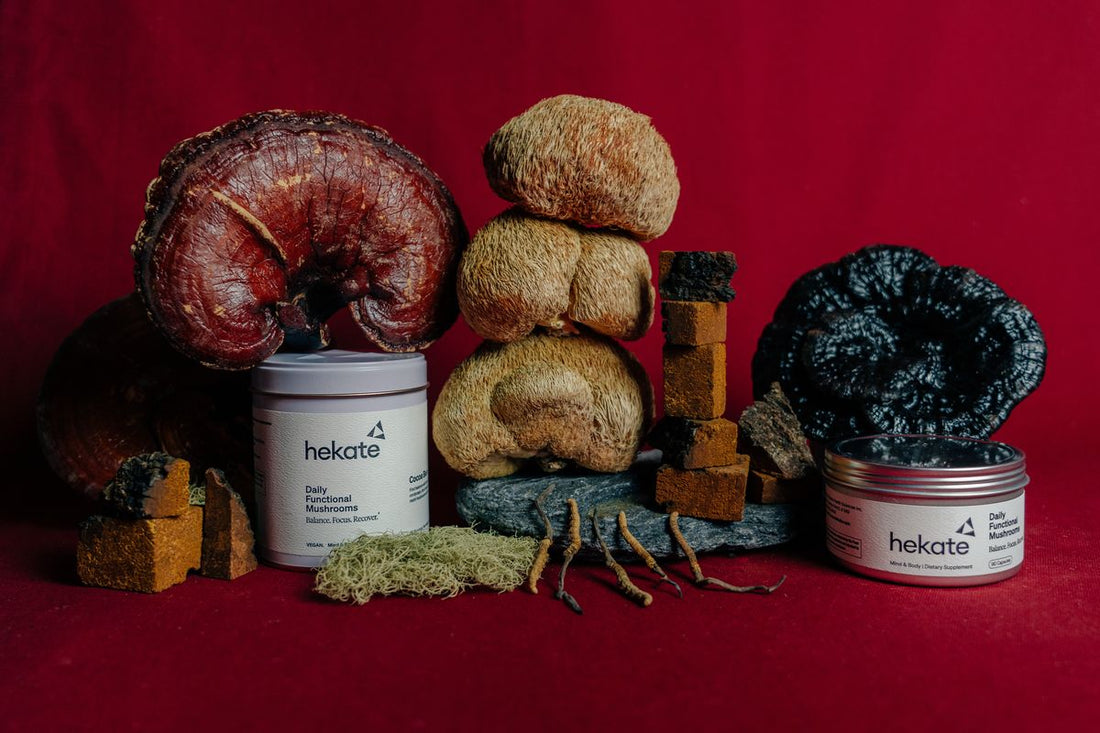Did you know that people use mushrooms in Traditional Chinese Medicine (TCM) for health and vitality?
“When I first started working at Hekate, I was learning more about our products and the functional mushrooms we use - chaga, lion's mane, cordyceps, and reishi - mushrooms whose names I was not yet familiar with. After I did more research and saw what they looked like, I realized I knew these mushrooms and their names in my native Chinese (Cantonese) tongue. 白桦茸 bái huà rōng (chaga), 猴头菇 hóu tóu gū (lion's mane), 蟲草 chóng cǎo (cordyceps), and 靈芝 líng zhī (reishi).
I am reminded of my mother’s day-long soup making sessions, and the jars and jars of TCM herbal ingredients that she would use; these mushrooms are traditionally used in cooking and in elixir herbal broths, and I remember them from my childhood. As a second-gen diaspora Chinese-Canadian, it grounds me to reconnect with my culture and to learn more about these mushrooms and their uses in Chinese medicine practices.” says Alger Liang 梁家傑, Content Producer, Hekate.
What is Traditional Chinese Medicine (TCM)?
Traditional Chinese Medicine (TCM) is a branch of medicine in China (over thousands of years old) that encompasses a range of holistic health and medicinal practices. It includes herbal medicine, acupuncture, massage, tai chi, and dietary therapy. TCM is widely used in the Sinosphere (people who speak Chinese). At its core, TCM is about maintaining your body’s balance through a holistic health practice while incorporating Confucian philosophies of mental and physical wellness.
Learning about Chinese cultural practices and understanding the healing properties of the mushrooms we use at Hekate:
Chaga 白桦茸 (bái huà rōng) - Whole-body protection from inflammation and oxidative stress.
Chaga helps reduce fatigue, increase focus, and lower blood sugar levels, blood pressure, and cholesterol. It also protects the body from cancer, inflammation, and oxidative stress. Chaga has been used in Traditional Chinese Medicine to preserve youthfulness, promote health, and encourage longevity.
Traditional Uses: steeped as a tea, powdered and mixed with water, used in soups
Flavour: sweet, slightly bitter

Lion’s Mane 猴头菇 (hóu tóu gū) “Monkey Head Mushroom” - Improve focus, memory, creativity & mood.
Lion’s mane is a fruiting body adaptogenic mushroom commonly used in cooking dishes throughout China and Japan to support brain and nerve function. Research shows that lion’s mane can help lower blood sugar levels and improve nerve damage.
Traditional uses: cooked both food and soups, and used as medicine
Flavour: sweet, neutral

Cordyceps 蟲草 (chóng cǎo) “Caterpillar Fungus” - Increase cardiovascular performance
Cordyceps is a fungus that lives on specific caterpillars in the mountains of China. It’s a powerful adaptogenic and immune-building herb that has excellent anti-aging properties. It is also frequently used to treat chronic fatigue, kidney disorders, and male libido. In addition, is used by athletes to build stamina and strength and contains adenosine, a nucleic acid that increases the production of the molecule adenosine triphosphate (ATP), which delivers energy to muscles.

Reishi 靈芝 (líng zhī) “Mushroom of Immortality” - Helps fight fatigue, stress, and anxiety.
Reishi helps with insomnia, reduces anxiety, stress, and promotes emotional well-being. It also helps to replenish Qi and nourish the blood. The first textual mentions of Reishi date back to the Han dynasty (over 2000 years ago), making it one of the oldest mushrooms known to be used medicinally.
Traditional uses: used in soups and medicine
Flavour: bitter

Resources:
If you are interested in reading more Traditional Chinese Medicine (TCM), the origins and folklore of these specific mushrooms, visit White Rabbit Institute of Healing, a resource dedicated to providing the best of both Western scientific and Eastern energetic healing practices (Traditional Chinese Medicine, Shamanic philosophies), as well as the Hua Foundation’s dried foods guide.

